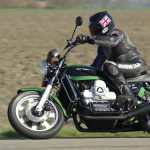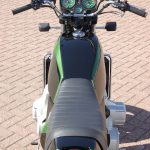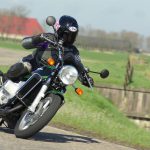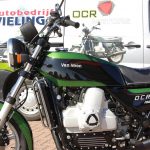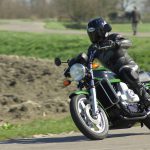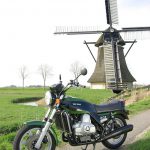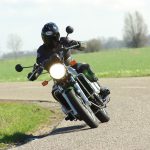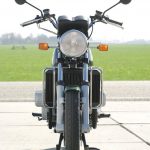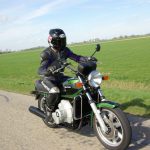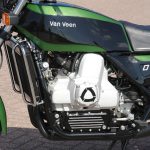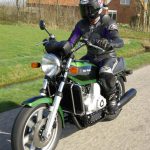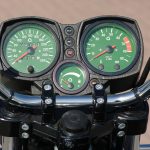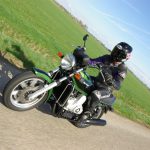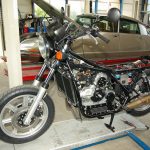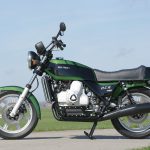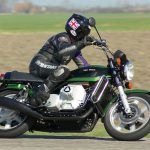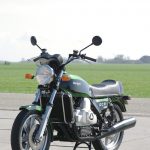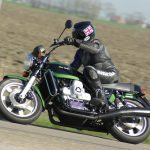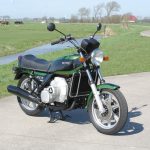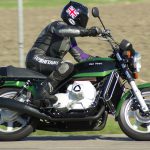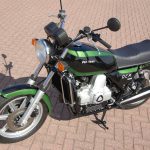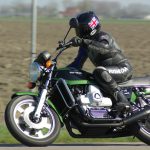Real world road test on Dutch highways and country lanes of the most expensive series production motorcycle ever produced
A quarter of a century ago rotary-engined motorcycles seemed set to be the next big thing, after the Norton RC588 scored a Wankel-engined bike’s greatest victory by winning the 1992 Senior TT in the Isle of Man in the hands of the late Steve Hislop at a then record speed of 121.38mph, after a thrilling battle with future four-time World Superbike champion Carl Fogarty’s Yamaha. Coupled with the Duckhams Norton team’s domination of the 1994 British Superbike championship, with riders Ian Simpson and Phil Borley finishing 1-2 in the points table, Norton might have expected to benefit from this win with a spike in demand for its F1 Sport race replica streetbike – but the indebted British company was sliding towards insolvency, and production was soon to shut down of the last Wankel-engined motorcycle money could buy. Until now.

For it’s once again possible to purchase a streetlegal motorcycle powered by an engine of the kind invented by German engineer Felix Wankel, whose prototype such design, featuring an eccentric rotor turning within a trochoidal chamber containing peripheral intake and exhaust ports, first saw the light of day in 1957, powering an NSU car. (See www.animatedengines.com/wankel.html for a visual illustration). But not from born-again Norton, whose current owner Stuart Garner set aside the prototype 700cc twin-rotor road racing engine he developed seven years ago on taking the company over, in favour of trying to meet demand for the air-cooled Commando 961 retro-twins that have proved such a huge worldwide hit, and developing the V4 1200cc Norton hyperbike launched at last year’s Birmingham Show.
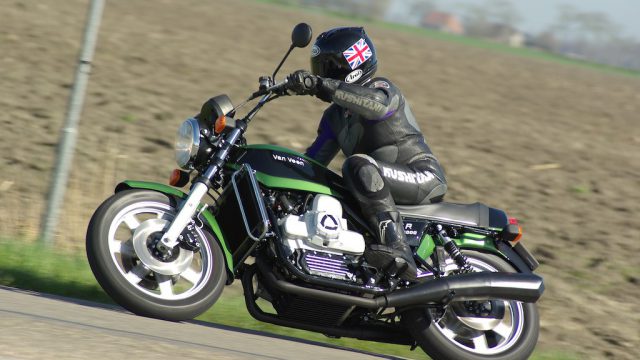
Instead, the rotary-engined motorcycle you can buy right now is built in the Netherlands by OCR Motors www.ocrmotors.com, whose owner Andries Wielinga is in doing so making the past live again. For in the 1970s, Dutch two-wheeled tycoon Hendrik ‘Henk’ Van Veen produced what was then by far the most high-performance as well as the most expensive series-production streetbike money could buy, powered by the same 100bhp twin-rotor engine equipping the NSU Ro80, the world’s first production rotary-engined car which entered production in 1967. The Van Veen OCR 1000, of which he sold 38 examples to the likes of US magazine publisher Malcolm Forbes and German Opel/Sachs heir-cum-professional playboy Gunther Sachs at a retail price equivalent to Euro 40,000 today (twice the price back then of a BMW R100RS, or half the cost of a Rolls-Royce Silver Shadow limousine!) before the company closed down in 1981, was in every way symptomatic of the age of excess – which makes Wielinga’s decision to build ten exact replicas of the late-‘70s production Van Veen OCR Rotary retailing at Euro 85,000 tax free, either a very brave or a very foolish decision, depending on which way you look at it!
We also recommend:
BMW R1200GS vs Honda CRF1000L Africa Twin: in-depth review
2017 BMW K1600B Bagger Video Review
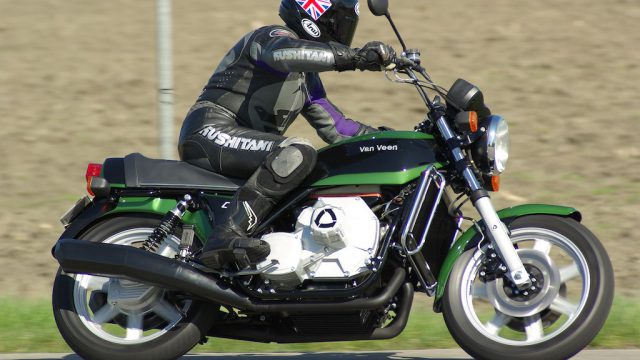
Van Veen’s eponymous company imported Kreidler 50cc mopeds and minibikes to the Netherlands from Germany in such volume during the ‘60s and ‘70s – Dutch sales of Kreidlers passed the 100,000 mark in 1971 – that he was able to go Grand Prix racing in the 50cc ‘tiddler’ category with his own specially developed Van Veen Kreidlers, and see his riders win four World championships, starting with Jan de Vries in 1971. But, that very same year, Van Veen had gone from little to large in taking the first steps towards establishing his own series-production motorcycle brand. He did so by creating a 100bhp prototype road bike featuring a 1000cc Mazda Cosmo rotary engine shoehorned into a Moto Guzzi V7 frame, still with shaft final drive, and although the result was significantly challenged aesthetically, its performance was so impressive by the standards of the era – 100bhp was a lot back then, when the newly launched Kawasaki Z1 über-bike ‘only’ made 82bhp – Van Veen decided to put such a bike into production using the NSU engine manufactured by Comotor in Luxembourg..
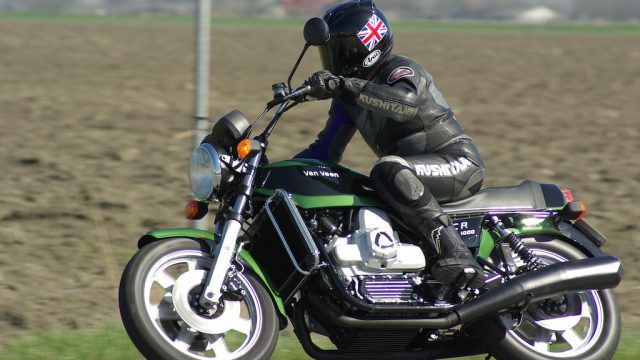
To do so, he gave the job of designing it to one of his GP riders, 24-year old Jos Schurgers, who finished third in the 50cc World Championship in 1971 on a Van Veen Kreidler, before repeating the placing in the 1973 125cc World series on his self-built Bridgestone twin, an amalgam of parts from the Japanese firm’s 175cc Dual Twin roadbike, and the Van Veen Kreidler singles. But Schurgers managed to achieve all this in between creating the rotary-engined Van Veen OCR 1000 (standing for Oil-Cooled Rotors) with the help of British designer Simon Saunders – better known today as the proprietor of the Ariel Car Company, which also produces its own highly innovative motorcycle design, the Honda-powered Ariel Ace V4. The result duly made its debut at the Cologne Show in October 1974, where its show-stopping impact was such that some leading executives of BMW Motorrad were reportedly fired by the company’s Executive Board, on the ground that they ought not to have allowed the German manufacturer to be thus overshadowed in its crucially important home market show! The OCR also succeeded in sidelining the equally new 999cc flat-four Honda Gold Wing by its sheer presence, thanks to Schurgers’ ground-breaking styling that was later widely copied by other manufacturers – and its cost. At a time that the world was shakily recovering from the 1973 oil embargo crisis, when the quadrupling of petrol prices had put an end to decades of cheap fuel, the idea of launching such an expensive, excessive and above all thirsty motorcycle (high fuel consumption and dirty emissions have traditionally been the achilles heel of Wankel engines) seemed decidedly risky.
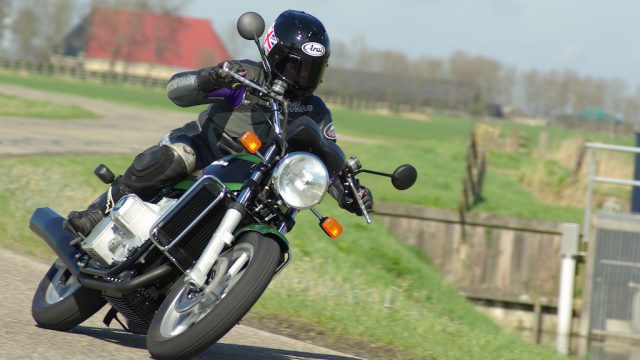
But Henk Van Veen pursued his dream, establishing a factory to manufacture the OCR 1000 in his key potential market for such a bike, West Germany. This was located at Duderstadt, just two kilometres from the DDR’s barbed-wire Iron Curtain frontier, and in 1976 a select few journalists visited it to ride the pre-production version of the bike. This had a remarkable specification for its time, with 100.4bhp delivered at 6,500rpm by the twin-rotor engine measuring 996cc in terms of the swept volume of the trochoidal rotor chambers, amounting to the equivalent of 1,693cc under the FIM’s 1:1.7 equivalency formula. Sourced from Comotor, this was essentially a joint-venture project between rotary pioneers NSU and traditional avantgarde thinkers Citroën, who installed it in their Birotor GS model – but an agreement was made to also supply the engine in batches of 50 to Van Veen. Installed in the OCR 1000, the twin-rotor engine already delivered 60bhp at just 3,000rpm, and in spite of a 292kg dry weight, performance was impressive, with a 0-100kph acceleration in just 3.6s, and a top speed of 224kph. The 0-200kph time was 16sec – impressive for the day, and pretty good even now for a sports tourer, which is what the OCR 1000 essentially was, especially when fitted with the optional very protective fairing designed by Schurgers. However, complaints from outside testers about poor throttle response, a flawed gearchange, and ineffective brakes – a critical factor on such a fast, heavy bike with minimal engine braking – saw Van Veen forced to delay production while these issues were addressed.
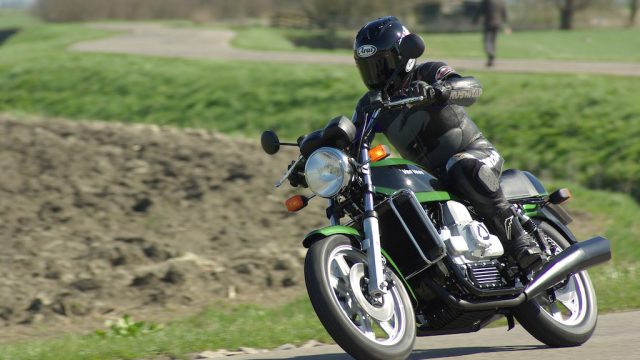
But addressed they were, and one year later in 1977 production of the Van Veen OCR 1000 got under way – although the Dutch entrepreneur’s target of producing 2,000 bikes annually always seemed hopelessly optimistic, even without the problems of engine supply which would shortly hit the project. For, after just a handful of bikes had been constructed and delivered to eager, well-heeled customers, using the first batch of 50 motors supplied from Luxembourg, production of the engine stopped, and Comotor folded soon after. There had been technical problems with the rotor’s tip seals – a recurring problem on early rotary engines, even for Mazda which eventually resolved the issue – plus the now Peugeot-owned Citroën had ceased production of the poorly-received Birotor after making just 847 examples, while NSU was now part of the VW empire, and in 1977 made the last of the 37,204 examples of the Ro80 to be built. Van Veen staggered on with production, with the final original OCR 1000 of the 38 built completed in 1981, before everything ground to a halt, and the factory closed.
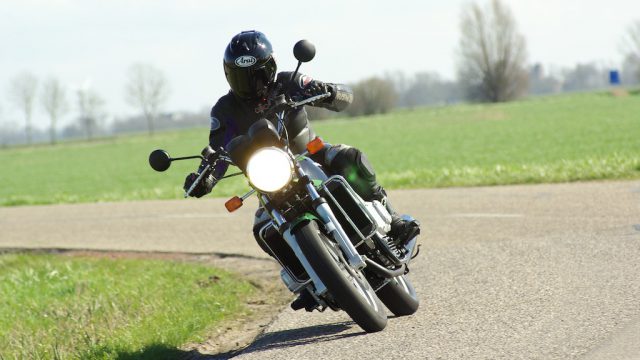
But now, 40 years later this Van Veen ultrabike is back in production, thanks partly to Dutch rotary-engine enthusiast Ger Van Rootselaar, who purchased the entire stock of unassembled parts from Van Veen when the Duderstadt factory shut. From these, he assembled Van Veen OCR 1000 no. 39 for himself, but had no intention of doing anything more until he met up with Andries Wielinga, based in the nearby north Holland town of Wommels, and a restorer of classic Citroën cars – including of course the very rare GS Birotor. “I’ve rebuilt two of these so far, and their technology was very interesting,” says Andries. “I ride bikes on the road, so when Ger Van Rootselaar decided he wanted to sell his Van Veen OCR parts because they were just sitting there gathering dust, he had two people who wanted to buy them, one German and one English. But he realised that if he sold them that would be the end of him ever making any new bikes himself – so he came to see me and we got talking. We agreed that I’d buy the parts from him, and he’d build the engines for me. That was in 2009, and that’s how it all started, since when we’ve digitalised the original drawings, and built up a complete parts stock to build ten motorcycles, using in most cases the original suppliers. I’m making the exact same bike from forty years ago, with all the original parts just as Van Veen made them back then. We tracked down every small part supplier, even down to the ones making silly things like the special kind of tie wraps for the cables – it took two months of searching, but we got them specially made! We wanted to make a completely authentic original bike, and even if some of them took half a year to track down, we managed to find all the parts to do so, except for the tubular steel frame, which is made by Nico Bakker to exactly the same design as the original, and of course the tyres, which are Michelin Macadam. Otherwise, this bike is history on wheels – but brand new!”
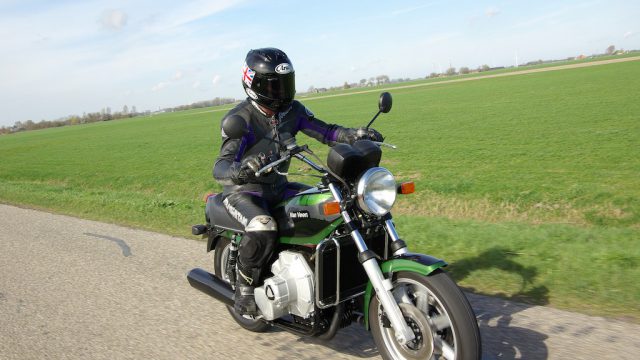
I suppose from that point of view the born-again Van Veen OCR 1000 isn’t so much a replica, as the continuation of production forty years down the line, with mostly original period parts acquired as part of the factory clearout, even down to the Ronal cast aluminium wheels made by a Mercedes-Benz/BMW car supplier, which were strictly futuristic at a time when everything else in the marketplace had wire wheels. Also avantgarde for back then were the modern-sized 42mm Van Veen telescopic forks with Koni internals, the twin Koni shocks nitrogen gas shocks with three-way preload adjustment, and the trio of 280mm Brembo cast-iron discs with two-piston Brembo calipers, which apparently cured the braking problems experienced with the stainless steel discs originally fitted. It may seem strange now, but all this stuff was extremely leading edge back in the late’’70s, and partially justified the bike’s very steep price tag.

Fast forward forty years, and it seems Andries Wielinga is trying to trump that, but with a time warp motorcycle that’s only available in just one colour, the original classy-looking black-and-green livery – the colour green was a Van Veen trademark, and his 50cc GP racers featured it too, only combined with patriotic Dutch orange! Delivery time is three months from the customer placing an order, and the price includes a two-year unlimited mileage warranty – the same as Van Veen offered back then. Just ten bikes will be built – four of which have already found customers – reflecting the number of engines held in stock, and indeed the Comotor twin-rotor motor fitted to the bike, with wet sump lubrication for the oil-cooled rotors (OCR, remember!) and a watercooled engine casing – hence the large radiator – is built up by Ger Van Rootselaar with uprated rotor tip seals, reflecting Mazda’s successful resolution of this single most contentious rotary engine issue. The four-speed gearbox with gear primary, shaft final drive and a dry twin-plate diaphragm clutch with hydraulic operation, was developed and manufactured for Van Veen by Porsche, in keeping with the calibre, and the price tag, of the motorcycle.
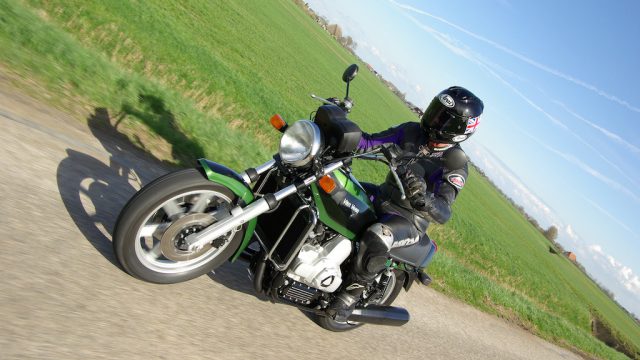
The chance to spend an afternoon riding this back-to-the-future bike revealed an enticing blend of old and new, that in some ways was nevertheless rather frustrating. I’ve ridden lots of rotaries down the years, mostly Nortons, and while the engine’s visual appearance often turns off traditionally-minded bikers, I must admit to be seduced by the Wankel engine’s smooth running, compact build (even in the case of the OCR, which on the basis of the FIM’s 1.7:1 equivalency formula is equivalent to a 1700cc twin) and broad, rideable spread of power. Thumb the starter button to fire up the OCR (the starter motor comes from a Johnson outboard engine, since Van Veen was also the Dutch distributor for them!), and the twin-rotor engine bursts immediately into life via the twin-choke Solex carb’s automatic cold start setting, before settling to a fast-sounding but totally vibration-free 1,300rpm idle, accompanied by the trademark offbeat rotary burble that’s halfway between a two-stroke’s high-pitched crack and a four-stroke’s deeper rumble – call it a three-stroke!
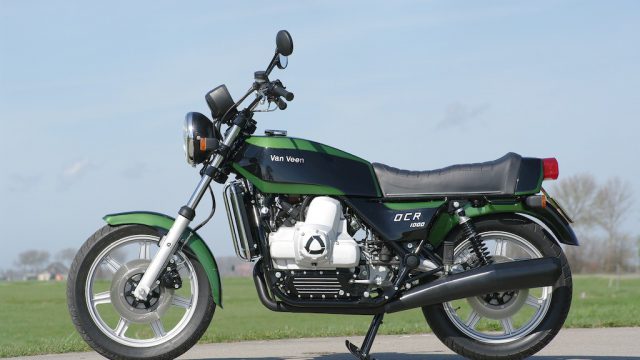
Having only ever ridden a 588cc twin-rotor Norton Rotary streetbike, I was unprepared for the depths of performance delivered by the Van Veen’s engine with almost twice the capacity and practically double the rate of acceleration, in spite of its heavy weight. Notch bottom gear on the street-pattern left foot shifter, and you can feel the OCR pull smoothly away from literally off idle, with impressive wide open acceleration from 2,000rpm upwards without any risk of lifting the front wheel, thanks to the long 1550mm wheelbase and also the fact the heavy motor (because of the cast iron rotors) is carried way low in the bike. The Comotor engine motors hard and fast with a totally seamless power delivery toward the 6,500rpm redline – and beyond! There’s no built-in revlimiter on the Bosch/Hardig CDI, and perhaps there should be, because several times I realised with a start that I’d been seduced by the smooth-running engine to send the tacho needle beyond the 7,000rpm mark, seemingly without the build of power falling off even though it’s supposed to peak out at 6,500rpm, with 100.4bhp on tap there, matched to 13.8mkg of torque at just 3,500rpm. That means this thoroughly modern engine is a delight to use, with waves of grunt just waiting for you each time you change gear, to propel the revs back towards the red zone again. With the 160kph/100mph mark showing on the speedo at just 4,200rpm, and 100kph/60mph smooth running at just 2,500rpm, both in top gear, the rotary motor has serious reserves of performance which it’s fun to exploit – but without the slightest undue vibration at any time. Thanks to that fabulous motor, this is a very untiring bike to ride hard, in spite of its heavy weight and large capacity. The gearchange is OK by shaftie standards, though there’s a clunk when changing from first to second through neutral, which is however easy to find at rest. And the hydraulic-operated diaphragm clutch is quite easy and precise to use, if not quite as light-action as I’d expected.
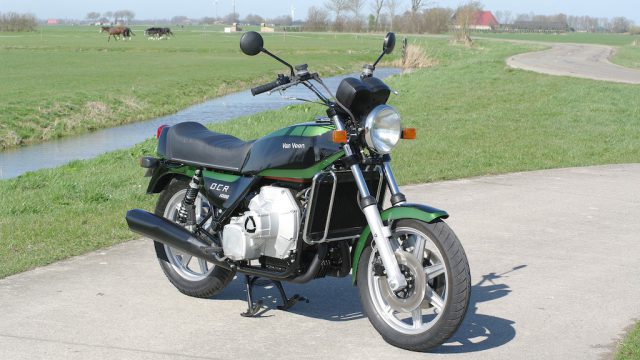
The OCR’s riding stance is very ‘70s, upright but pretty comfortable until you get much over 140kph, when you start to struggle to hold on. The location of the right footrest is annoying, though – the clutch housing protrudes into your ankle bone, which means you can’t reach the rear brake pedal properly, and also can’t park your toes on the footrest. And without much engine braking to speak of on the twin-rotor motor, you do have to use both front and rear brakes very hard to stop. Really, the brakes fitted to the OCR aren’t up to arresting the significant performance of such a fast, heavy bike – you have to squeeze like mad on the non-adjustable front brake lever, and somehow find a way of stamping hard on the rear brake pedal to get it to do so – eventually. It’s the usual triumph of expectation over delivery in braking terms that you get from a Superbike of the Seventies when viewed in the context of the 20-teens, and this reincarnation of such a bike also disappoints in terms of suspension compliance. Konis were the hot tip in the twin-shock era, but while the Bakker frame steers as well as Nico’s creations always do, in spite of that long wheelbase and the rangy 29-degree fork rake, the rear suspension feels way oversprung, probably in order to counter all that torque and the substantial weight transfer under hard acceleration of such a heavy bike. The relatively primitive 42mm Van Veen period forks with Koni internals and zero damping adjustment feel very stiff and not very compliant – they don’t like bumps much, through the hefty weight of the bike as a whole helps settle any chatter before it gets out of hand. But you can’t really feel what the front Michelin tyre is doing, and this is pretty important with a Euro 85,000 package you need to bring home in one piece, especially with the skinny 18-inch tyres and all that weight.

I can’t help thinking Andries Wiesinga has missed an opportunity here. Nowadays, a bike like this with such a fabulous high-performance engine deserves much better suspension and brakes to allow you to exploit that performance in safety, and he should fit modern Öhlins forks and Brembo radial brakes to the OCR 1000 to let his customers do so – especially at that price! Instead, you must exploit the thoroughly modern performance of that crown jewel of an engine via period handling hardware that’s not up to scratch, and that’s a pity. Reproducing the bike in original guise is one thing, but to include all the period drawbacks when they’re easily resolvable is a mistake. My test confirmed that the OCR was way ahead of its time in terms of concept, and performance, but the old-school brakes and suspension stop you enjoying the fruits of that.
Maybe Andries Wielinga will listen, and get the message….. Log on to www.ocrmotors.com to find out!
